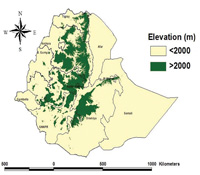Epidemiology and distribution of malaria in Ethiopia
About 75% of the landmass of Ethiopia is malarious and 68% of the Ethiopian population, estimated at about 54 million in 2010, live in malaria risk areas. As you can see from Figure 5.3, malaria is a risk in the western and eastern lowlands and central midlands. However, it is absent or the risk is low in the central highlands, where the altitude (or elevation) is 2,000 metres or more above sea level, as Figure 5.3 shows. As you will see later, the reason is the effects of altitude on the habitat of the mosquito vector, and the development of the parasite inside the mosquito.

The exact number of people getting sick and dying of malaria every year in Ethiopia is not known. However, it is known that millions of people get sick and tens of thousands of people die due to malaria every year, and that rates of mortality (death) and morbidity (illness) dramatically increase during epidemics. The distribution of malaria in Ethiopia is not uniform. There are areas where the risk of malaria is high and there are areas where the risk is low. There are even areas, 25% of the country, that are malaria free.
You learned in Section 5.1 above that malaria transmission is classified as stable or unstable. The three most important factors that affect the distribution of malaria and its severity in Ethiopia are:
- Temperature
- Humidity (the amount of moisture in the air)
- The availability of water collections in which the mosquito vectors can breed.
Altitude, vegetation and rainfall have indirect effects because of their impact on temperature, humidity and availability of water collections for vector breeding.
The distribution of malaria in Ethiopia varies from place to place due to the above factors directly or indirectly affecting the pattern of malaria transmission. For example, the distribution of malaria in Ethiopia is largely determined by altitude. Altitude affects the pattern of malaria distribution in Ethiopia through its effect on temperature. Risk of malaria is highest in the western lowlands of Oromia, Amhara, Tigray and almost the entire regions of Gambella and Benishangul Gumuz. The midlands of Ethiopia between 1,000 and 2,200 metres altitude experience seasonal transmission of malaria with sporadic epidemics every few years. In the eastern lowlands of Ethiopia (primarily Afar and Somali), malaria is endemic only along the rivers, as this part of the country is largely dry away from rivers. Transmission is limited by the lack of water collections for mosquito breeding and low humidity due to low rainfall and sparse vegetation. The central highlands of Ethiopia are free of malaria mainly due to the low temperatures, which slows the development of the vector and the parasite.